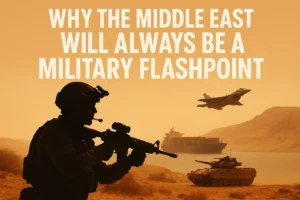For military strategists and defense planners, no region is more critical or more volatile than the Middle East. Stretching from the Mediterranean to the Persian Gulf, this region has been the battleground of empires, the arena of proxy wars, and the focal point of global security concerns for decades. Despite shifting power balances, the Middle East will continue to be a flashpoint due to its strategic geography, energy reserves, religious divisions, and ongoing great-power rivalry.
1. Strategic Geography and Chokepoints
The Middle East is home to some of the world’s most militarily significant maritime chokepoints. Whoever controls these routes influences global trade and energy flow:
- Strait of Hormuz: Around 20% of global petroleum liquids (21 million barrels/day in 2023) transit this narrow strait, making it a target for constant military surveillance and potential blockades. Iran’s naval forces frequently threaten closure, a scenario NATO and U.S. forces train to counter.
- Suez Canal: Handling 12% of global trade annually, this passage has been the site of past wars (1956 Suez Crisis, 1967 Six-Day War) and remains critical for U.S. and allied naval deployments.
Any military disruption here would immediately escalate into a global crisis.
2. Oil, Gas, and Strategic Vulnerability
Energy resources aren’t just economic, they’re military lifelines. Armies, navies, and air forces worldwide depend on Middle Eastern oil.
- 48% of global proven oil reserves and 40% of natural gas reserves are concentrated in the region.
- Saudi Arabia exported 7.3 million barrels/day in 2023, and Qatar’s LNG supplies kept much of Europe’s energy grid stable during the Russia–Ukraine war.
Control over energy flows makes the region a perpetual battleground for influence. For militaries, securing supply lines through the Gulf is as important as deterring adversaries.
3. Religious and Sectarian Wars Fueling Proxy Conflicts
Religious and ideological divides in the Middle East often translate into wars fought by proxies, shaping military alliances:
- The Sunni vs. Shia conflict is exemplified by the Saudi–Iran rivalry. Both powers use militias and armed groups in Yemen, Iraq, Syria, and Lebanon to wage indirect wars.
- Groups like Hezbollah, the Houthis, and ISIS destabilize entire states, forcing U.S., Russian, and regional militaries into ongoing counterinsurgency campaigns.
For armed forces, these conflicts blur the line between conventional warfare and irregular insurgencies.
4. The Israeli–Palestinian Conflict and Regional Security
Israel remains one of the most militarily advanced states in the world, but it operates in a permanent state of alert.
- The 2023–24 Gaza conflict reignited global debate, drawing in Iran-backed groups, U.S. military deployments, and regional Arab states.
- Israel’s Iron Dome missile defense system intercepts thousands of rockets annually, showcasing how advanced military technology adapts to constant low-intensity threats.
This conflict ensures that the region will always demand military readiness and rapid-response capabilities.
5. Great Power Rivalries: A New Cold War in the Desert
The Middle East is a chessboard where world powers project strength:
- United States: Maintains forward-operating bases in Qatar, Bahrain, Kuwait, and Syria. The U.S. Fifth Fleet, headquartered in Bahrain, secures Gulf waters.
- Russia: Entrenched in Syria since 2015, it uses Tartus and Hmeimim bases to project power into the Mediterranean.
- China: Expands influence via military logistics and energy security, even opening its first overseas base in Djibouti to secure Red Sea trade.
This overlapping presence means every conflict risks escalation into global confrontation.
6. Fragile States and Endless Wars
The region is a patchwork of fragile states where insurgency, terrorism, and civil war are constant military challenges:
- Syria’s civil war has drawn in the U.S., Russia, Turkey, Iran, and countless militias.
- Yemen is now one of the world’s worst humanitarian crises, with Iranian-backed Houthis directly targeting Saudi and U.S. assets.
- The rise and fall of ISIS showed how quickly extremist groups can seize territory and force global coalitions into prolonged military operations.
According to the UNHCR, over 15 million displaced people in the Middle East (2024) are a direct result of war, proving that instability here always carries military consequences.
Conclusion: A Military Flashpoint for the Foreseeable Future
The Middle East isn’t just another region; it is the testing ground for modern warfare, proxy conflicts, and great-power rivalries. Control of its chokepoints, energy reserves, and alliances can decide the global military balance. For strategists, it remains the region where readiness, deterrence, and rapid deployment are not optional; they are essential.
As long as the Middle East sits at the crossroads of energy, faith, and power, it will remain the world’s most critical military flashpoint.









